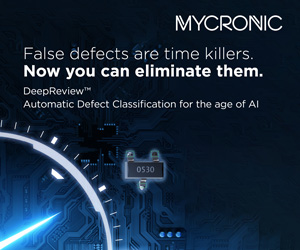When CfX Becomes the Biggest Data Platform
By Michael Ford, Aegis Software
When CFX (Connected Factory Exchange) becomes the biggest data-exchange platform ever seen for the assembly manufacturing industry, who will be among those who capture that value? For sure, data exchanged using the CFX standard, has defined content that spans every facet of manufacturing and related processes, with complete compatibility of data between vendors, such that pretty much any event that happens, anywhere, at any time, can be detailed and captured. This provides exceptional opportunity for value creation. Let’s see who, where, or, in the coming age of AI, what, steps up to deliver.

MichaelFord2 1
To find out the areas in which value lies with CFX, we can start simply, by taking an extrapolation of what we already have in the industry. Whether we look at MES applications, machine vendor software, or even in-house developed applications, the solutions that yield the most value are those that have access to the most data. It is not just about the quantity of data either. Though machines and software technology move on inexorably, the same old ground-rules apply, such as Garbage-in, Garbage-out (GIGO) continue to apply. There are simple “gotchas” when it comes to data acquisition. Data that is late, out of sequence, or of unknown occurrence, is garbage. Data from which the source cannot be determined, is garbage. Data that cannot be placed into the context of a recognizable event, is garbage.
Inconsistencies in meaning of the data are even worse than garbage. Knowing that you know nothing from the data, still leaves you in a known condition. Not knowing that the data is incorrect however, and then taking actions based on it, will do significant damage. The ingredients for the assurance of data value within CFX is at the core of the specification of the standard. CFX delivers a great quantity of specific, accurate, and timely data, which provides the opportunity to enhance the value of any existing machine or system environment.
Actually, it will not be as straightforward as that sounds. Many systems are developed so as to be geared around the available data at the time they were conceived. The design of many solutions is based upon a certain flow dependent on the availability of data. Functions, reports and documentation are structured to follow, but more seriously, calculations and automated decisions, as well as support for human decision support, are based on algorithms that again, only consider the available data, which is an incomplete analysis. Though it is easy to add new data fields into the database within an application, it is much more difficult to revise algorithms, rules, and operational flows to take full advantage of the new data fields.
For this reason, we are likely to see two distinct “waves” of CFX adoption going forward. The first wave will be where CFX replaces existing bespoke and legacy data acquisition methods, opening existing systems to a new level of standardization in terms of communication capability. This is quite significant in itself, as a great deal of R&D time and effort will be saved by eliminating the creation and support of multiple legacy and bespoke interfaces. Existing systems will be able to access a far wider range of data sources service and additional destinations.
The second wave of CFX-inside applications will then come along, where algorithms and flows have been engineered specifically to utilize the previously unavailable data. These applications will be smarter, more automated, more comprehensive, being able to make more decisions in real-time.
Consider the case of software from an advanced machine vendor. While their software already carries a high degree of value, in that it is tied directly with the actual operation of the machine and related hardware, such as automated feeders, there is a distinct lack of understanding about, for example, the precise physical materials that will be placed on the feeder, or will be coming to the machine next. A difference in any material used consecutively at a feeding position is likely to trip the machine up at changeover, or even during normal operation.
Also lacking is specific information about the schedule, as relates to the grouping of a high-mix of products, which is essential in order to further optimize machine and line-balancing programs. Very specific information about the performance and accuracy of preceding production processes that have taken place on each production unit, such as solder paste printing before SMT, can be used to ensure that placement alignment with the paste is done correctly. Information about deviations can then be fed down to the next process in the line, for example AOI, so that compensation in the inspection measurements can be implemented automatically.
As well as compensation, that same data is then used to suggest possible correction back to the process where the variation and deviation originated, in order to reduce the likelihood of defects. These new real-world values that can be delivered through the use of CFX data exchange between machines can be developed and provided equally by machine vendors (within context), advanced digital MES suppliers or, to an extent, even by in-house development teams. Quality, performance and consistency in manufacturing can be improved in this way, not just by an increment, but a step-change.
There is similar scope for the enhancement of other functions that will take into account all relevant and available sources of data. Supply-chain JIT lean material logistics, active quality management, traceability, assembly instructions, and continuously adaptive planning are just a few of the areas in which we can expect to see a strong second wave of CFX enhanced software application enhanced values.
The best CFX-based applications will be those that understand holistically, and in detail, the real nature of manufacturing operations and their inter-dependencies, and are not just based on a single, simple vision and practice. Software solutions themselves must be delivered on specifically developed modern digital MES platforms, on which every facet of data can be utilized. A critical factor for any MES solution to be able to make automated decisions, will be the ability to put the CFX-derived data into context with the product design and process work assignment. The link between the digital product model and the digital process model provides the key reference points for how and why each process is working, how operations were assigned, as well as the definition for needed materials. Multiple solutions will be seen to work together, each enhancing the other. Connection of different solutions in the CFX environment will be possible without the need for specific integration effort, as each system will likely evolve to share data in a way that is not dissimilar to that of the connection of the human nervous system. Once technology utilizing CFX reaches this stage, we will likely see the emergence of artificial intelligence, perhaps centralized, perhaps distributed throughout many operations that are coordinated by a central controller. This may become the third wave.
The journey through the waves of digital factory enhancement are made possible by the critical mass of support of the CFX standard, which is about to start, as the initial publication of the standard this year comes ever closer, and as production trials start to pick up the pace.












